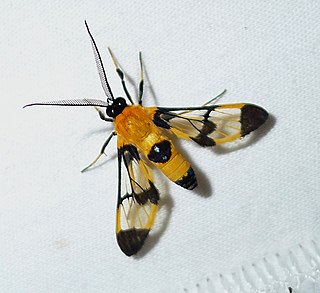| Loxophlebia peralta | |
|---|---|
| Scientific classification | |
| Kingdom: | Animalia |
| Phylum: | Arthropoda |
| Class: | Insecta |
| Order: | Lepidoptera |
| Family: | Arctiidae |
| Genus: | Loxophlebia |
| Species: | L. peralta |
| Binomial name | |
| Loxophlebia peralta Schaus, 1912 | |
Loxophlebia peralta is a moth of the Arctiidae family. It was described by Schaus in 1912. It is found in Costa Rica. [1]

Moths comprise a group of insects related to butterflies, belonging to the order Lepidoptera. Most lepidopterans are moths, and there are thought to be approximately 160,000 species of moth, many of which have yet to be described. Most species of moth are nocturnal, but there are also crepuscular and diurnal species.
William Schaus was an American entomologist who became known for his major contribution to the knowledge and description of new species of the Neotropical Lepidoptera.

Costa Rica, officially the Republic of Costa Rica, is a country in Central America, bordered by Nicaragua to the north, the Caribbean Sea to the northeast, Panama to the southeast, the Pacific Ocean to the southwest, and Ecuador to the south of Cocos Island. It has a population of around 5 million in a land area of 51,060 square kilometers. An estimated 333,980 people live in the capital and largest city, San José with around 2 million people in the surrounding metropolitan area.

